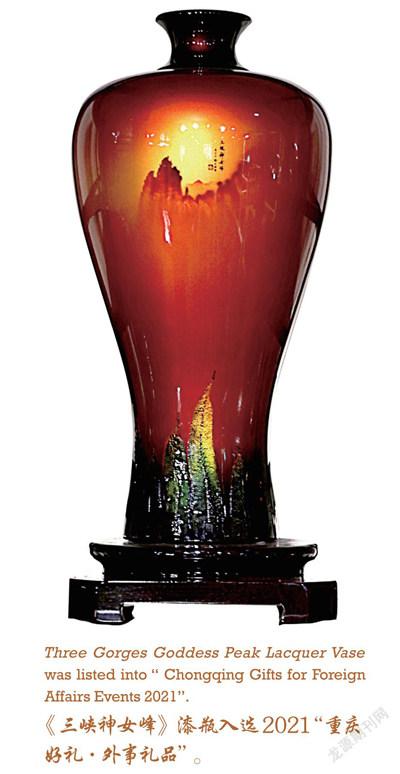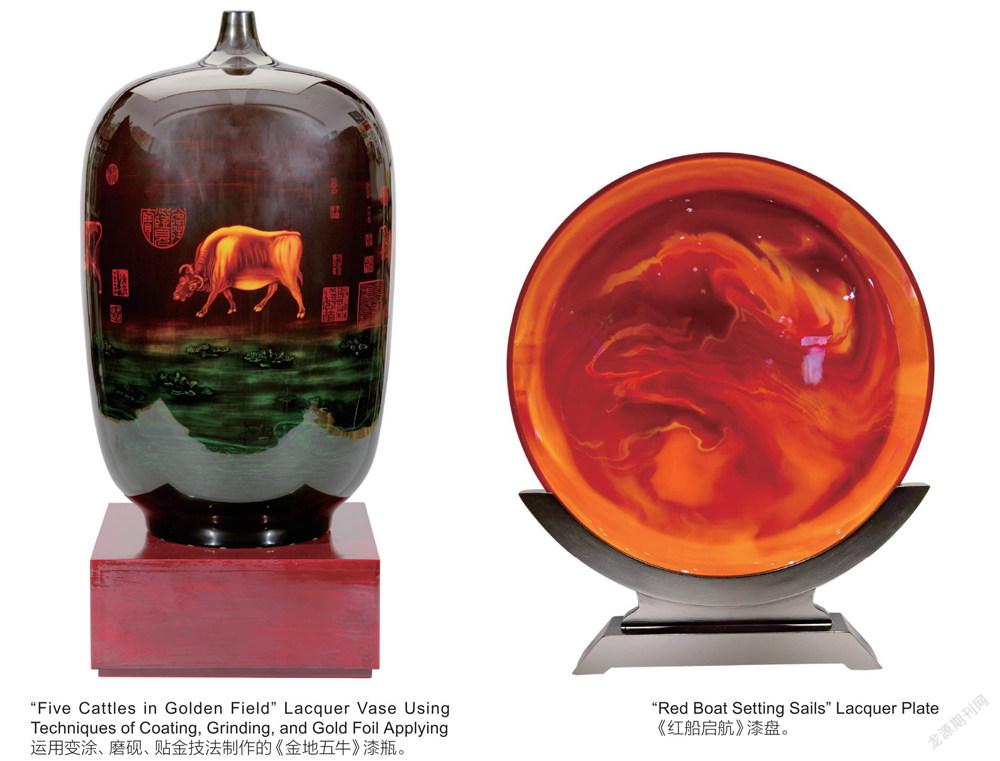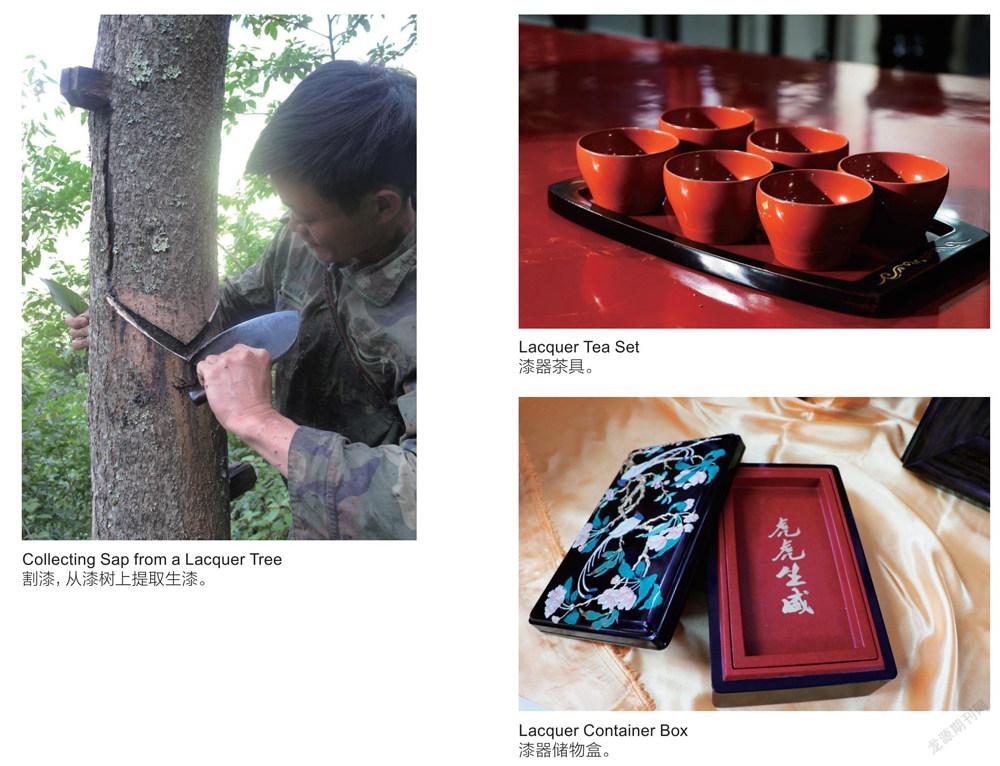山神漆器&三峡神女峰漆瓶 大山献出的国礼
刘丁睿




Shanshen Lacquerware & Three Gorges Goddess Peak Lacquer Vase
State Gifts From the Mountain City
Lacquerware, embroidery, pottery, stone carving, paper-cutting...A dazzling variety of intangible cultural heritage handicrafts are exhibited for the reviewing of the first batch of selected traditional artworks and handicrafts in Chongqing. When preparing the exhibition, Cai Zerong, president of Chongqing Industrial Arts Association, was onsite to give instructions for exhibition arrangements and to communicate with exhibitors. He is known as a master of Chinese craft and arts, a representative inheritor of the wooden lacquer art in Chengkou, Chongqing.
In Chongqing Shanshen Lacquer Art Museum, hundreds of pieces of lacquerware are exhibited, including lacquer vases, lacquer plates, lacquer paintings, folding screens extending a few meters and palm-size teacups. It is breathtaking how exquisite they are, as shiny as the pearl, as smooth as the silk. Among them, a lacquer vase is outstanding, with featured elements of the Three Gorges. Cai Zerong said “this craft is Three Gorges Goddess Peak Lacquer Vase inspired by the legend of Wushan Goddess Peak. Elegant and delicate, the ware reminds us that Chongqing is a beautiful city of lush mountains and lucid rivers.” Visitors will think of Chongqing whenever they see the state gift.
Chengkou Lacquerware
Chengkou County, boasting the highest forest coverage rate in Chongqing, grows the lacquer trees, one of the top five lacquers in China. This land is warm in winter and cool in summer with good air quality, providing favorable climate and environment for producing high-end lacquerware.
“Lacquer art has a long history in China. In ancient times, lacquerware was not only used in daily life, but also used as the offering in important occasions such as sacrifice. Chengkou lacquerware is historically known as the lacquerware of Ba, dating back to 3,000 years ago according to archaeological findings. In modern times, lacquer art is widely adopted in houses decoration, furniture producing, especially the furniture used as dowry. In Chengkou, lacquerware can be found everywhere in the life of the local people.” This experience kindled Cai Zerong’s interest in lacquer art when he was young and he started his apprenticeship in his teens.
According to Xiu Shi Lu (Records of Traditional Lacquerware), there are 471 techniques of lacquer art, including engraved gold, filled-in lacquer, carved lacquer, and rhino skin. Producing lacquerware takes a long time. After being lacquered, a ware needs to be dried for 7-10 days before the next process, and over a hundred of processes are required to decorate a ware. Making a piece of lacquerware may take at least one to two months or three to five years at most. For large-scale and complicated works, teamwork of more than 10 artisans is required.
“It is true that once you’ve made up your mind, perseverance is needed to finish the endeavor. Lacquer art has been passed down in China for thousands of years. Now it is our mission to further inherit it.” Said Cai Zerong, “Since the day I took up lacquer art, it has become my lifelong dedication.”
Lacquerwares as Gifts
Shanshen lacquerware, literally the lacquerware of mountain god, is a product of nature and represents the charm of mountains. In 2010, Chengkou lacquerware was listed as Intangible Cultural Heritage of Chongqing. In 2015, Shanshen Lacquerware was honored as “Protected Eco-origin Product of China”, receiving the Golden Awards of China Tourism Commodities Competition for many times. In 1993, Cai founded the Chongqing Shanshen Lacquerware Co., Ltd., expanding it from a small factory to an industrial park. Now, Shanshen Lacquerware has grown into a well-known Chinese brand with global fame.
Lacquerwares named Five Cattles in Golden Field, and Five Blessings achieved awards of craft designs at home and abroad successively. The Three Gorges Goddess Peak Lacquer Vase and other delicate works have been sent to foreign guests as state gifts. This lacquer vase also served as a gift to present China’s craftsmanship in many foreign affairs events, such as the Annual Meeting of the Chongqing Mayor’s Advisory Council, Asia-Pacific Cities Summit and ASEAN-China Ministerial Meeting.
Ushering into a Better Future
In 2019, the training class of Shanshen Lacquerware (intangible cultural heritage) to alleviate poverty was opened. With the operation mode of “company + impoverished people + lacquer craft”, this class aimed to develop and inherit the intangible cultural heritage, and to drive employment. “Traditional craft is born from innovation, and Shanshen Lacquerware is no exception. A strong sense of crisis will appear if we don’t come up with new ideas or make progress.” As a leader of craft and arts in Chongqing, Cai often thinks about the way to inherit the Chengkou lacquer art, and to research and develop cultural creative lacquer ware with great popularity. He also thinks about the way to integrate intangible cultural heritage with rural revitalization and promote its harmonious development with cultural tourism.
Cai said that “now, lacquerware has changed from common household goods to souvenirs and collections. Its good implication brings people great joy of life.” He was playing with his new work, a scarlet red lacquer vase, with gentleness and determination in his eyes. “Going forward, we plan to establish a lacquerware museum to introduce the artwork to the public, providing a platform for more people to appreciate and get to know the charisma of lacquer culture.”
Photo/Interviewee
漆器、绣品、陶器、石雕、剪纸……精美的非遗工艺品让人目不暇接,在重庆市首批传统工艺美术精品评审布展现场,重庆市工艺美术行业协会会长蔡泽荣一边指导展品摆放,一边与送展人交流。他还有另外的身份:中国工艺美术大师、重庆城口木胎漆器制作技艺非遗代表性传承人。
在重庆山神漆器艺术馆,记者看到这里陈列着上百件漆器作品,除了漆瓶、漆盘、漆画,还有大到宽数米的屏风,小到手握的茶杯。漆器表面流光溢彩,质感精致细腻,色彩鲜艳明亮,触感如丝绸般顺滑,精美程度令人惊叹。其中,一件融合三峡元素的漆瓶格外亮眼。“这件作品叫做三峡神女峰漆瓶,以巫山神女峰为背景,整体典雅细腻,蕴含重庆‘山水之城,美丽之地’之意。”蔡泽荣介绍说,客人看到这件礼品,就会想到重庆,记住重庆。
城口之漆
城口县森林覆盖率居重庆第一,这里生长的大木漆更是中国五大名漆之一。城口的气候冬暖夏凉,空气质量优良,为生产优质漆器提供了得天独厚的自然条件。
“中国制造漆器历史悠久,古代漆器不仅是日常用品,也用于祭祀等重要场合。城口漆器在历史上又称巴国漆器,考古发现距今已有3000年的历史。在近代,漆艺的利用与房屋、家具,尤其是婚嫁中的陪嫁家具结合得更多,漆器在我们当地人的生活中无处不在。”耳濡目染下,蔡泽荣从小就对漆艺产生兴趣,十多岁便拜师学艺。
据《髤饰录》记载,漆艺有471种技法,常见的有描金、填漆、雕漆、犀皮等。漆器的制作周期非常长,每上一遍漆要干燥7~10天才能进行下一道工序。装饰环节需要上百道工序。要做好一件漆器,费时少则一两个月,多则三年五载。面积较大、工艺复杂的漆器,往往需要集合十余人的团队力量才能完成。
“现在想来很有道理,干一件事情就要一条路走到底。几千年都没有消失的东西,更需要我们把它传承和发扬下去。”蔡泽荣说,“既然入行做了漆工,深耕漆藝文化就是我一辈子的事业。”
漆器之礼
山神漆器,寓意是大自然的产物、山的神韵。2010年城口漆艺入选重庆市非物质文化遗产名录;2015年山神漆器获“中华人民共和国生态原产地保护产品”称号,并多次获中国旅游商品大赛金奖。1993年,蔡泽荣创办“山神漆器”,把一个小厂房做成了一个产业园。“山神漆器”已成长为中国著名品牌,产品远销国外。
其中,《金地五牛》《五福临门》等漆器作品相继获得国内外多项工艺设计大奖;《三峡神女峰》漆瓶等精品被当做国礼赠送外宾。《三峡神女峰》漆瓶更是在重庆市市长国际经济顾问团会议、亚太城市市长峰会、东盟外长会等外事活动中作为赠礼,向世界展示中国工匠精神。
美好之物
2019年,山神漆器技艺非遗扶贫培训班开班,通过“公司+贫困群众+漆器技艺”的运营模式,实现非遗传承发展、非遗带动就业。“传统工艺都是创新而来的,山神漆器也是如此。如果几个月都没有新的思路,技术也停留在原地,我就会有深深的危机感。”作为重庆工艺美术行业带头人,蔡泽荣时常思考,如何做好城口漆艺的传承、漆器文创品的研发,以及非遗与乡村振兴的结合促进、与文旅的融合发展。
“如今,漆器由普通的家居生活用品向纪念品、珍藏品转变,它们的美好寓意带给人们美好生活的享受。”蔡泽荣用手摩挲着他最新创制的大红漆瓶,目光柔和又坚定,“接下来,我们还将打造漆器博物馆,让漆器走进大家的视野,让更多的人认识和了解漆文化的魅力。”
部分图片/受访人提供

